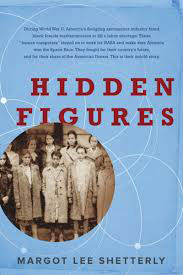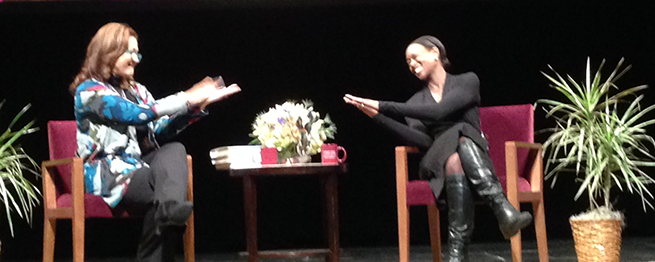 This week, my mother and I heard Margot Lee Shetterly, author of Hidden Figures, speak at the University of Minnesota’s Hubert H. Humphrey Distinguished Carlson Lecture Series. Shetterly’s book tells the true story of Mary Jackson, Katherine Johnson and Dorothy Vaughan — three of dozens of African-American women who worked in the 1950s and ‘60s for NASA in math, science and computing. Margot Lee Shetterly is the daughter of one of the early black male scientists at the NASA installation near Hampton, Virginia. She grew up knowing these amazing women and she grew up thinking that math, science and engineering was simply what black people did. This acknowledgement, which she makes in the opening pages of the book, is the backdrop for the marvelous story she tells.
This week, my mother and I heard Margot Lee Shetterly, author of Hidden Figures, speak at the University of Minnesota’s Hubert H. Humphrey Distinguished Carlson Lecture Series. Shetterly’s book tells the true story of Mary Jackson, Katherine Johnson and Dorothy Vaughan — three of dozens of African-American women who worked in the 1950s and ‘60s for NASA in math, science and computing. Margot Lee Shetterly is the daughter of one of the early black male scientists at the NASA installation near Hampton, Virginia. She grew up knowing these amazing women and she grew up thinking that math, science and engineering was simply what black people did. This acknowledgement, which she makes in the opening pages of the book, is the backdrop for the marvelous story she tells.
It was a large and completely packed venue Tuesday night. Ms. Shetterly was eloquent and erudite and it was an inspiring speech to have had the privilege to hear. When the audience spilled out on the sidewalks of the university campus after the event, there was a palpable energy and hope in the air. We had had our better angels called out and our beleaguered spirits responded. There was zip in our step, an urgency to our conversations, a new direction to our thoughts and dreams.

Hubert H. Humphrey Distinguished Carlson Lecture Series, Feb 21, 2017.
After the prepared remarks, Michelle Norris asked Ms. Shetterly a few questions. One of the questions was a variation of Why did we not know about these women before now?!, a question Ms. Shetterly said she fields again and again. Her answer: Our imaginations weren’t large enough for these amazing black female mathematicians who worked in America’s space program in the 1940s-60’s. There were too many things in the way during that time — racism and sexism were two of those things, but there were others, as well. Many trouble us still — the same ‑isms, of course, but also our unexamined assumptions, our biases, our tribal natures, and our general ugliness (my words, not hers).
“Looking beyond” is a theme in this remarkable book — and it could’ve easily been the title of the book, as Michelle Norris pointed out. The movie uses it brilliantly when Al Harrison and Katherine Johnson stand before a chalkboard filled with math. He tells her he needs her to look beyond the numbers at math they don’t even have — and she seems to be the only one among all those NASA scientists and mathematicians who can do that. Ms. Shetterly, in turn, invited us to look beyond easy stereotypes and characterizations, past the usual stories and unexamined history, so that we can uncover other narratives as amazing as the ones she’s given us in Hidden Figures. Her confidence that these important stories are everywhere and remain untold simply because no one tells them was positively rousing.
In closing, Michelle Norris said that there was a program/effort in place to get this book in the hands of high schoolers — news which made Margot Lee Shetterly beam. There’s a young reader’s version of this book, I know — and I’ve heard it’s wonderful — but the original version is beautifully written and easily captures the interest of teens. I hope it’s the version they receive if they receive one. A tremendous amount of history is covered in such a beautiful and accessible way — through story. Such power! Our kids need these kinds of stories — we all need these stories. We need our imagination stretched and enlarged for the work that is ahead of us.
Three generations of our family are reading this book right now. I can’t think of another book that has called us to do that all at once. I commend it to you and yours — it will not disappoint.
(P.S. The movie is most excellent. The book is superb.)
